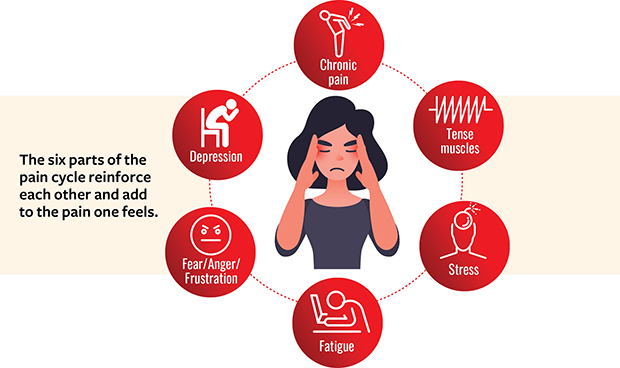
Last updated on October 17th, 2024 at 03:51 pm
If you’re living with fibromyalgia, it’s important to make time for self-care. It’s a chronic (long-lasting) condition that causes muscle pain and tenderness all over the body. This can make it hard to move, relax, or sleep, and it can cause mood and memory problems, too. NIH MedlinePlus Magazine asked two top fibromyalgia experts (and NIH grantees!) for tips on how to support your physical and mental well-being.
1. Exercise regularly
It may hurt to move at first, but research shows that gradually increasing exercise can reduce pain. Start with gentle movements such as tai chi or yoga, said Leslie Crofford, M.D., Division Director for Rheumatology and Immunology at Vanderbilt University Medical Center. Low-impact aerobic activities such as swimming, walking, and biking are great options, too.
Communication between the brain and body is altered in fibromyalgia. But regular exercise helps the brain become more accustomed to your body’s movements, Dr. Crofford explained. A physical therapist or exercise physiologist (a professional who creates fitness programs) can provide you with more personalized exercise plans.
2. Reduce stress
Stress can make fibromyalgia worse, so it’s important to spot stress triggers in your life. Cognitive behavioral therapy (CBT) can teach you ways to cope with emotional stress and depression. CBT can also teach you how to avoid negative self-talk, organize tasks so they are less tiring, and cope with pain flare-ups.
You may not be able to do all the things you once did or to do them in the same way, but pacing yourself can help you try to conserve your energy each day. Relaxation techniques such as guided visualizations and breathing exercises can also help. Doing too much can make your symptoms worse, so be kind to yourself!

3. Get enough sleep
In fibromyalgia, fatigue can affect pain, which can worsen fatigue… and the cycle continues. That’s because the same neurotransmitters (which carry messages between the brain and the rest of the body) that control pain also control sleep, mood, and memory, said Daniel Clauw, M.D., Director of the Chronic Pain and Fatigue Research Center at the University of Michigan. This makes getting enough sleep essential.
Try following good sleep habits: Go to bed and wake at the same time each day, reduce daytime napping, and try to only use your bed for sleep.
4. Incorporate complementary health approaches
In addition to CBT, tai chi, and yoga, vitamin D or magnesium supplements may help reduce symptoms, too. But talk to your doctor about how these could interact with medications you’re taking—just because something is “natural” doesn’t mean it is safe! Some people may seek out massage therapy and acupuncture to improve fibromyalgia symptoms including pain, stiffness, fatigue, and depression. However, these approaches have not been well tested in people with fibromyalgia specifically.
5. Learn as much as you can
If you or someone you know has fibromyalgia, check out expert-backed information about the condition at MedlinePlus and the National Institute of Arthritis and Musculoskeletal and Skin Diseases. The National Center for Complementary and Integrative Health’s website also breaks down research about treatment options for fibromyalgia.
Consider joining an NIH clinical trial to help advance scientific research on fibromyalgia. This research is what leads to our understanding and treatment of the disease.
6. Understand that, unfortunately, there’s no simple solution
“There’s no easy fix with chronic pain,” said Dr. Clauw. People with chronic conditions must take an active role in managing their symptoms with lifestyle changes. But remember to always consult your health care provider about what treatment is best for you!
*This article was originally published in September 2018. It has been updated.
